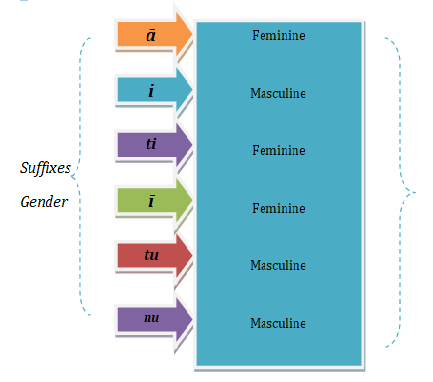If a noun ends with a vowel sound then they are called vowel nouns. As we have studied in the earlier portion of the course about the vowels, this might easy to understand. As we know there are 4 basic vowels in Sanskrit, aa, ee, uuh, ruh. Now it’s time to see how the vowel in noun changes.
First, let us see i vowel noun
-i (masculine/feminine)
| अग्नि | Singular | Dual | Plural |
|---|---|---|---|
| Case 1 (Subject) | अग्निः agniḥ | - | अग्नयः agnayaḥ |
| Case 2 (object) | अग्निम् agnim | - | अग्नीन् agnīn |
| Case 3 (with) | - | - | अग्निभिः agnibhiḥ |
| Case 6 (of) | - | - | अग्नीनाम् agnīnām |
As you can see here that how the vowel changes according to the form and number of persons.
Now let us see u vowel
-u (masculine/feminine)
| गुरु | Singular | Dual | Plural |
|---|---|---|---|
| Case 1 (Subject) | गुरुः guruḥ | - | गुरवः guravaḥ |
| Case 2 (object) | गुरुम् gurum | - | गुरून् gurūn |
| Case 3 (with) | - | - | गुरुभिः gurubhiḥ |
| Case 6 (of) | - | - | गुरूणाम् gurūṇām |
One thing you should’ve noticed that case 1 plural of masculine is a strengthened one; such words are seen in Bhagavad-Gita too:
धर्मक्षेत्रे कुरुक्षेत्रे समवेता युयुत्सवः
dharmakṣetre kurukṣetre samavetā yuyutsavaḥ
On dharma’s field, the field of Kurus, all assembled wanting war …
Previous nouns were both masculine and feminine in nature; now let us see the nouns that are specifically feminine in nature. They are ā , ī , and ū nouns.
ā (feminine)
| विद्या | Singular | Dual | Plural |
|---|---|---|---|
| Case 1 (Subject) | विद्या vidyā | - | विद्याः vidyāḥ |
| Case 2 (object) | विद्याम् vidyām | - | विद्याः vidyāḥ |
| Case 3 (with) | - | - | विद्याभिः vidyābhiḥ |
| Case 6 (of) | - | - | विद्यानाम् vidyānām |
ī (feminine)
| वापी | Singular | Dual | Plural |
|---|---|---|---|
| Case 1 (Subject) | वापी vāpī | - | वाप्यः vāpyaḥ |
| Case 2 (object) | वापीम् vāpīm | - | वापीः vāpīḥ |
| Case 3 (with) | - | - | वापीभिः vāpībhiḥ |
| Case 6 (of) | - | - | वापीनाम् vāpīnām |
ū (feminine)
| चमू | Singular | Dual | Plural |
|---|---|---|---|
| Case 1 (Subject) | चमूः camūḥ | - | चंवः caṃvaḥ |
| Case 2 (object) | चमूम् camūm | - | चमूः camūḥ |
| Case 3 (with) | - | - | चमूभिः camūbhiḥ |
| Case 6 (of) | - | - | चमूनाम् camūnām |
tad (feminine)
| तद् | Singular | Dual | Plural |
|---|---|---|---|
| Case 1 (Subject) | सा sā | - | ताः tāḥ |
| Case 2 (object) | ताम् tām | - | ताः tāḥ |
| Case 6 (of) | - | - | तासाम् tāsām |
Now let us consider some primary suffixes and their gender so that you might be able to recognize them in the sentence.

गम् + ति → गति
gam + ti → gati
go → path, way
स्मृ + ति → स्मृति
smṛ + ti → smṛti
Remember → remembrance, what is
Turning adjectives into feminine
We have so far learned about vowel nouns and its suffixes of both genders. Now let us try to change the gender of the following sentences. Here the adjectives have been changed by changing a ending to ā.
स प्रियः → सा प्रिया
sa priyaḥ → sā priyā
He is beloved. → She is beloved.
स सुन्दरः → सा सुन्दरी
sa sundaraḥ → sā sundarī
He is beautiful. → She is beautiful.
(Interestingly from all the adjectives that we have studied, this is the only one that uses I as a feminine)


